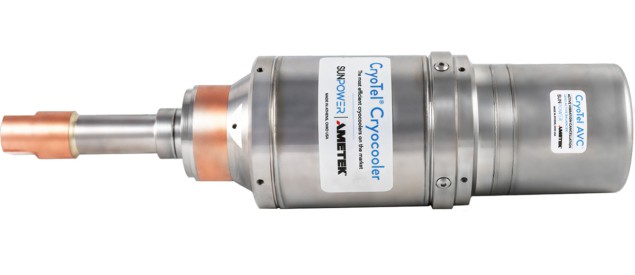Free-piston cryocoolers from Sunpower, Inc., a business of AMETEK, Inc., deliver the performance needed for efficient single-photon emission while still fitting inside a standard rack-mounted module

Emerging systems for quantum communications and cryptography rely on the ability to transmit single photons with high fidelity. Single-photon emitters based on quantum dots cooled to cryogenic temperatures have been shown to produce indistinguishable single photons with high brightness, but for practical use in real-world communications networks both the single-photon source and its cooling mechanism must be integrated into a standard rack-mounted unit.
Scientists at TU Berlin have recently shown that this tricky integration can be achieved with a Stirling cryocooler supplied by AMETEK Sunpower. They have built a plug-and-play testbed for quantum key distribution that emits single-photon pulses at telecoms wavelengths, and that combines the quantum-dot device, the cryocooler, and all the associated optical components into a standalone 19-inch module (Appl. Phys. Rev. 9 011412).
Other iterations of such quantum-dot emitters would typically require a bulky and complex cooling system to enable operation at temperatures below about 50 K, but the scientists at TU Berlin found that the compact Stirling cryocooler was able to maintain the required operating temperature without introducing unwanted vibrations into the system. These cryocoolers are already widely used in scientific instruments that require a low-noise background, such as infrared and radio-wave detectors for telescopes and superconducting quantum-interference devices (SQUIDs), while recent design improvements are widening their appeal for applications with more demanding requirements.
The Sunpower design features a free-piston mechanism that exploits gas bearings to enable friction-free operation. “The motion of the piston is driven by an electronic controller, while the oscillation of the moving parts charges the gas bearings to enable the piston and displacer to levitate on a film of gas,” explains Cliff Fralick of AMETEK Sunpower. “There is no lubrication used, and no maintenance needed, which ensures that these hermetically-sealed cryocoolers will have a long and dependable lifetime.”
Such contact-free operation has made these free-piston cryocoolers a popular choice for applications that demand reliable and robust cooling solutions. One stand-out example was a device that was designed to cool an imaging spectrometer onboard NASA’s RHESSI space mission, launched in 2002 to study the energetic particles released in solar flares. Despite a target mission lifetime of just two years, the cryocooler enabled the spectrometer to continue capturing images for 16 years, until the instrument was finally decommissioned in 2018.
Sunpower’s free-piston design also delivers higher cooling powers and a better thermal efficiency than other cryocoolers on the market. One of the most powerful models in the company’s range of compact devices, the Cryotel GT, removes heat at a rate of 16 W with 240 W of input power while maintaining a temperature of 77 K, achieving a cooling efficiency of nearly 20% of the theoretical Carnot limit. In addition, the high specific power of the design allows for a smaller size, with the GT measuring 276 mm long and 83 mm diameter, and with a mass of only 3 kg.
Such design parameters have made Sunpower’s cryocooler a popular choice for instruments that need to pick up faint signals. “In order to detect something that produces very little energy, it is necessary to generate a very cold background to minimize the noise floor and improve the signal-to-noise ratio,” says Fralick. “That applies to many scientific applications such as infrared detectors, SQUIDs, low-noise amplifiers, telescope instruments, and deep-space communications.”
Recent innovations have now widened the appeal of Sunpower’s cryocoolers for a range of new applications, particularly within the growing field of quantum technology. The company has recently released a premium version of the GT that offers a minimum temperature around 10 K lower than the standard version, while also increasing the usable heat load capacity at temperatures between 30 to 50 K.
“The GT typically has a minimum temperature of approximately 38 K, while the new GTLT can provide meaningful cooling power at temperatures down to 30 K,” says Fralick. “By boosting the cooling performance at lower temperatures, the GTLT expands the range of applications that can be addressed with our technology.”

The company has also been working to reduce the level of vibrations exported from the cryocoolers, since excessive vibrations created by the oscillating components have limited the adoption of Stirling cryocoolers in certain applications. All the cryocoolers are fitted with a passive balancer as standard, while Sunpower also offers the option of Active Vibration Cancellation (AVC) across all the instruments in its product range.
The company’s initial AVC offering reduced the level of exported vibrations by a factor of five, while its latest release – the AVC-GEN2 balancer – delivers a further two-fold performance improvement. “This yields a ten-fold reduction in exported vibrations compared to the passive balancer, which is a critical benefit for customers who are exploring applications in quantum technology,” says Fralick. “Combining the CryoTel GTLT with the AVC-GEN2 active balancer offers a compact solution that delivers the performance needed for these applications.”
Indeed, the QKD system developed at TU Berlin makes use of both these innovations to optimize the performance of the quantum-dot emitter while also minimizing vibrations inside the confines of the turnkey module. Another key customer in the quantum sector is UK start-up company Aegiq, which has developed a commercial single-photon source that exploits compact cryogenic cooling, ensuring that its module fits inside a 19-inch rack.
Sunpower is continuing to make improvements to its products and technology, with an ongoing drive towards colder temperatures, higher capacity cooling, and lower levels of exported vibration. “Quantum applications are growing quickly, and Sunpower is focused on delivering the technology advances that meet the demands of customers in this field,” says Fralick.
- SEO Powered Content & PR Distribution. Get Amplified Today.
- PlatoData.Network Vertical Generative Ai. Empower Yourself. Access Here.
- PlatoAiStream. Web3 Intelligence. Knowledge Amplified. Access Here.
- PlatoESG. Carbon, CleanTech, Energy, Environment, Solar, Waste Management. Access Here.
- PlatoHealth. Biotech and Clinical Trials Intelligence. Access Here.
- Source: https://physicsworld.com/a/cool-tricks-offer-new-solutions-for-quantum-networking/



